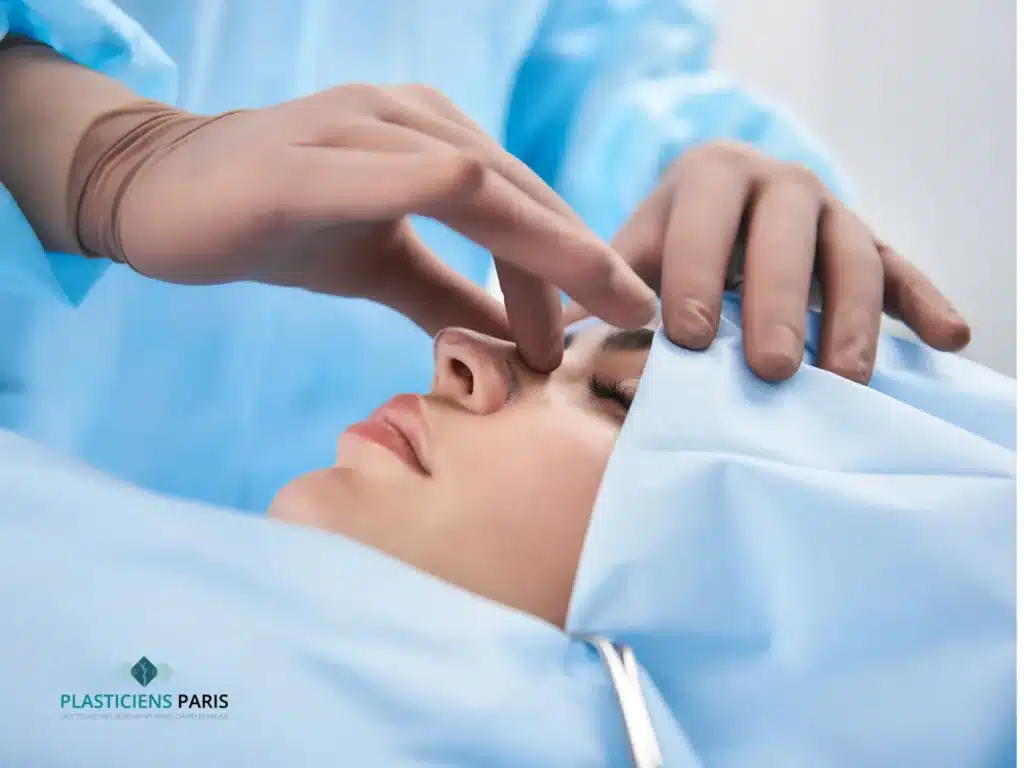
A cutting-edge technique in aesthetic nose surgery, ultrasonic rhinoplasty combines mechanical precision with respect for nasal anatomy. Unlike traditional methods where the nasal bridge is fractured and then reconstructed, this approach focuses on preserving existing bone and cartilage structures. Thanks to tools such as the Vectra Canfield and the Orthonose system, it enables fine planning, meticulous surgical gestures and stable results over time. Our plastic surgery center integrates these digital tools and ultrasonic techniques to offer an approach that is both precise and safe.
What is ultrasonic rhinoplasty?
This is a conservative surgical technique, in which the surgeon modifies the shape of the nose without dismantling the osteo-cartilaginous arch. The original anatomy (dorsum, septum, ligaments) is largely preserved, limiting the risk of secondary irregularities, asymmetries or altered appearance.
Le travail osseux est réalisé à l’aide d’un piezotome, un instrument à ultrasons qui sculpte l’os sans le fracturer brutalement. Ce dispositif permet des découpes millimétrées, précises et sans traumatisme en ciblant exclusivement le tissu osseux, sans léser les muqueuses, les vaisseaux ni les nerfs adjacents.
Prior to the operation, we perform a 3D model of the nose using the Vectra Canfield system. This enables the patient to visualize a simulation of his or her future profile, useful for refining aesthetic objectives. In addition, a personalized surgical guide can be 3D-printed using Orthonose software, in order to secure bone movements during the operation.
What are the indications for ultrasonic rhinoplasty?
This procedure is primarily intended for patients who have never undergone nose surgery, and who have a moderate osteo-cartilaginous bump, a slight nasal deviation or a tip to be corrected, but no major structural changes.
It is particularly indicated when the aim is to obtain a natural result, without altering the deep anatomy or reconstructing the nasal skeleton. On the other hand, it is less suitable for severely deformed noses, post-traumatic sequelae or secondary rhinoplasty.
What are the main advantages of ultrasonic rhinoplasty?
L’un des bénéfices majeurs de cette approche est de minimiser l’impact chirurgical sur les structures nasales. En évitant les gestes traumatiques, comme les ostéotomies classiques, la rhinoplastie ultrasonique induit souvent moins d’œdèmes, de bleus, et de douleurs dans les suites immédiates.
The nose retains its supporting structure. It is not "reconstructed" after being fractured, but adjusted in keeping with its natural geometry, which contributes to a more stable and natural result in the long term. This preservation of the dorsal arch also avoids some of the pitfalls of traditional rhinoplasty, such as hollows, secondary bumps or a "surgical" appearance.
Another interesting feature is 3D simulation with Vectra Canfield. This technology enables patients to discuss their aesthetic goals with their surgeon. The projected image serves as a shared reference for aligning expectations and precisely planning the procedure. Orthonose, for its part, converts the patient's data into a personalized osteotomy guide, used in the OR by our surgeons to secure bone gestures.
Ultrasound rhinoplasty: how the procedure works
Surgery is generally performed under general anesthesia. Depending on the case, outpatient hospitalization or an overnight stay in a clinic may be possible. The duration of the procedure varies according to the complexity of the remodelling.
L’abord peut être ouvert ou fermé. Après dissection, le chirurgien procède au remodelage osseux à l’aide du piezotome. L’outil vibre à haute fréquence pour sectionner l’os de manière sélective, sans provoquer d’impact ou de microfracture.
If necessary, the procedure may include recentering of the nasal septum, tip plasty or moderate reduction of the alar cartilage. However, the logic is always to preserve ligament attachments and structural lines for a stable, harmonious result.
At the end of the procedure, the practitioner applies an external splint, which should generally be kept on for 6 to 8 days. In most cases, no drill bit is required.
Convalescence after ultrasonic rhinoplasty
In the immediate aftermath, moderate swelling and a few bruises may appear, mainly on the lower eyelids. Pain is often limited and well controlled by simple analgesics.
L’attelle est retirée vers le 6e ou 7e jour, au cours de la première consultation postopératoire. Le nez reste sensible durant quelques semaines, notamment au toucher ou à la pression. La majorité des patients peut reprendre ses activités socioprofessionnelles au bout de 7 à 15 jours, même si le gonflement persiste encore quelque temps.
Il est conseillé d’éviter le sport, les lunettes, et les expositions solaires durant au moins 4 à 6 semaines. Le résultat initial est visible dès le retrait de l’attelle, mais l’affinement final se fait progressivement sur 6 à 12 mois, en particulier pour la pointe.
Il est néanmoins fréquent que le nez évolue légèrement au fil des mois, surtout si la peau est épaisse.
How much does ultrasonic rhinoplasty cost?
The price of an ultrasonic rhinoplasty varies according to a number of criteria, including whether it is a first-time procedure or a repeat operation. For a primary ultrasonic rhinoplasty, fees generally range from €7,500 to €8,500. For a more technically complex secondary rhinoplasty, the cost can reach €9,000 to €15,000, depending on the amount of reconstruction work required. A personalized estimate will be given to the patient at the initial consultation.
Cette intervention est le plus souvent réalisée pour des raisons esthétiques et ne donne donc pas lieu à une prise en charge par la Sécurité sociale. Toutefois, une exception est possible si une gêne fonctionnelle sévère (traumatisme, obstruction nasale persistante objectivée par un examen ORL) est documentée. Dans ce cas, la partie fonctionnelle de l’acte peut faire l’objet d’un remboursement partiel.
